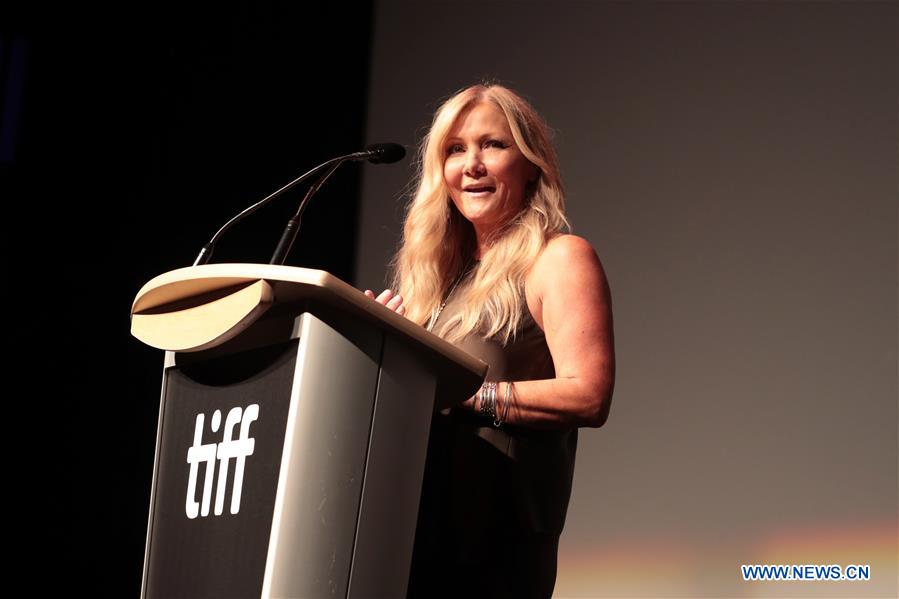
The file photo taken on Sept. 7, 2019 shows Jill Culton, writer and director of "Abominable," attending the world premiere of the film during the 2019 Toronto International Film Festival (TIFF) in Toronto, Canada. "I wanted to make sure the rest of the world saw a true representation of modern China and the people who live there," Jill Culton, writer and director of highly successful U.S.-China co-production "Abominable," said in a recent exclusive interview with Xinhua. (Pearl Studio/Handout via Xinhua)
by Julia Pierrepont III, Gao Shan
LOS ANGELES, Feb. 23 (Xinhua) -- "I wanted to make sure the rest of the world saw a true representation of modern China and the people who live there," Jill Culton, writer and director of highly successful U.S.-China co-production "Abominable," said in a recent exclusive interview with Xinhua.
"Abominable" is a co-production between the California-based DreamWorks Animation, a subsidiary of Universal Pictures, and the Shanghai-based Pearl Studio, a CMC company (formerly known as Oriental DreamWorks). The animated film, a testament to cross-cultural cooperation and the power of a shared creative vision, took the top spot in the North American box office over its opening weekend and has grossed more than 60 million U.S. dollars in North America for a global cume of 190 million dollars. It was one of the most successful U.S.-China co-productions of 2019.
"There is a huge part of China that the world had never seen and I very much wanted to celebrate that in the film," Culton told Xinhua.
The animated adventure, with a reported 75-million-dollar budget, follows a Chinese teenage girl who encounters a Yeti on the rooftop of her apartment building and embarks on an epic quest to reunite the magical creature with his family at the highest point on Earth, the majestic Himalayas.
The film was praised as a love letter to China by some film reviewers. The Hollywood Reporter magazine commented that "this handsomely made and easily digestible product seems perfectly geared for consumption on both sides of the Pacific."
"I was approached by the studios to tell a 'Yeti' movie. There was a subject, but no story yet, so there was a blank canvas on which I could create one. I was thrilled at the idea of creating new lore around the Yeti that was unique to this film," said Culton.
As a Westerner tasked with sensitively and accurately bringing to life a Chinese story, she felt it was vitally important that she and her entire team get every detail right so the film felt authentic to Chinese viewers as well as global viewers.
"The more I researched the Chinese countryside, I really fell in love with the amazing landscapes, waterways and iconic landmarks that I discovered," she said.
For accuracy in cultural and geographical details, Culton relied heavily on her co-creators at Pearl Studio.
"We would've never been able to achieve that level of authenticity without our partners at Pearl Studio. They really helped us design the modern city (based on Shanghai) down to every detail like the signage, food carts, scooters, and the visceral feeling you get from the city."
Pearl also designed the girl's apartment in the film so it would look typically Chinese, and helped the film's characters behave as the Chinese would, using appropriate mannerisms, customs and cultural etiquette -- like the tradition of taking your shoes off in the house or who sits down at the dinner table first -- all cultural nuances largely unknown to Western audiences.
"DreamWorks worked hand-in-hand with Pearl Studio on a daily basis. All of the big decisions when it came to story, casting and character design happened in tandem with DreamWorks and Pearl. There was mutual input in these areas," the director said.
Of equal importance to her was creating a young female hero that diverged from a more typical Disney character, "I really wanted a strong female main character that was not the typical princess, but a girl who was strong-willed, a risk-taker and enough to drive this impossible journey all the way across China to the Himalayas," she noted.
She told Xinhua she was very optimistic about the future of the Chinese animation industry. "There is definitely a desire there and talented people who are eager to create films. China is really going through a creative explosion when it comes to filmmaking. It's quite exciting to see."
"The fact that Pearl Studio chose to partner with an American company shows that they are willing to take the steps necessary to create global reaching, blockbuster films in China," she added. "I wouldn't be surprised if China becomes a powerhouse in this medium in the near future."
She pointed out that there are many China-based stories that would be interesting to explore in animation. "There is a whimsy and imagination that is a core part of Chinese folklore and that lends itself well to this medium."
But she advised that if China wants to reach a global market, the key would be "to pick those stories that have universal themes, stories where the characters are relatable in any culture and stories that resonate with the human condition."
"For me, story does not divide cultures, it shows us how very similar we all are. That is the magic of storytelling," she noted.